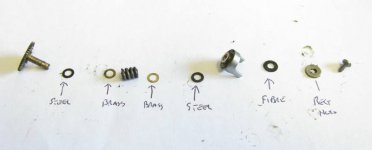........... Now, if their quality control had been up to snuff, maybe all those repairs wouldn't have been necessary....
This is interesting. According to Henry Scherer (in his site) the assembly of Contax cameras suffered from the workers trying do finnish as many cameras as they could to earn more money. BTW, let's remeber that before WWII the world has been in a depression starting a decade before.
Now, according to Henry in an email to me, the Kiev assembly shows a pathetic disregard of the workers for what they were doing.
But I am less and less prong to accept the Kiev explanation at least, as I start to deal with the mechanisms of other cameras. From this perspective it is very obvious to me that the Kievs are cameras (Contax designed) to last much more than others, but only in a kind of mummy status.
According to the technology of its time design, the Kievs cannot but work with grease, and grease cannot last for decades, nor abstain from gathering some dirt along time. Hence the customary need of CLA for these cameras.
So I would not say that the Kiev assembly line was award wining, but rather that from the perspective of today bad assembly is not the main factor for the Kiev need of CLA. These complex old-designed mechanisms cannot be expected to work as they went out of factory, even if they went out in the best possible health.
On the other hand, what is remarkable is the capacity of these cameras to come back to life, despite their complex manual mechanisms, after a very basic CLA.
I use the word "basic", in contrast to "easy". It is not easy because you have to memorize a lengthy process with the help of a parts box, as unfortunately almost no set of screws is alike the other, and you have some dozens of sets.
If you loose one screw there, you will not find another to replace it of the same size.
But it is basic in the sense that after you learn and repeat the process, it is not complex at all.
Lastly, kindly note that I have been refering to a basic CLA. Fixing problems is another totally different story, whose complexity depends each time on the problem in question, and most of the times it is hard or very hard.
Cheers,
Ruben


